TL; DR – Express is still the biggest game in town by orders of magnitude. Koa, Sails and Feathers continue to grow in popularity.
Framework: ‘a basic structure underlying a system, concept, or text.’
Last year we looked at popular frameworks across several programming languages, including JavaScript. In the latest iteration of our bi-annual RedMonk Programming Language Rankings my colleagues Stephen O’Grady and Rachel Stevens once again found JavaScript is a top three language.
Since we last looked at JavaScript we have had several improvements across various frameworks as the ongoing push and improvements based around ECMAScript continues. Indeed, some of the newer frameworks, such as Koa, make an explicit point of calling out their ECMAScript 2017 credentials.
Additionally, JavaScript remains the most important language for Serverless, and while support for other languages is expanding, we anticipate JavaScript keeping its place at the top of the Serverless table for the foreseeable future.
For the purposes of this analysis we once again looked at the frameworks we hear mentioned most frequently in our conversations around JavaScript. These frameworks are primarily focused on the server side, with the criteria that we hear the framework mentioned in conjunction with creating REST APIs. This is by no means a fully exhaustive list, but it does capture the most popular frameworks that we hear about being used with JavaScript (some frameworks are layered together, with frameworks such as SailsJS, KrakenJS and FeathersJS all built on Express).
There are many other incredibly popular JavaScript frameworks focused on other problem spaces that we have not included here, such as Socket.io, Derby and Meteor. Front end frameworks such as Angular, React and Vue are also outside the scope of this piece of research.
We received many comments on the previous version of this analysis, and have expanded the list of frameworks we included in our initial data gathering exercise. The full list is given below. As before, if there is a framework you feel we should be looking at, either in this context, or in the wider JavaScript ecosystem, please do add a comment below or let me know on twitter.
Framework Popularity
In our initial analysis, we looked at the popularity of the following frameworks
- Express
- SailsJS
- Koa
- Loopback
- HAPI
- Feathers
- Restify
- KrakenJS
- NodalJS
- TotalJS
- ThinkJS
- CompoundJS
- ActionHeroJS
- StrapiJS
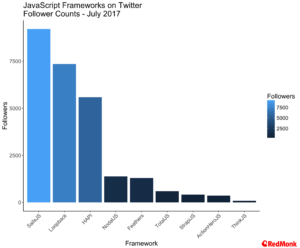
Six of the seven top frameworks remain the same as last year, with Restify replacing Kraken in the top tier. Feathers is showing strong incremental growth of over 50% once again.
On Stack Overflow we see a clear lead for Express over the other top tier frameworks.
Development Pace and the Future?
The overall pace of development across all the frameworks has slowed significantly. While there is no doubt that the number of JavaScript developers continues to grow, the development of many of the frameworks which popularized serverside JavaScript has all but ceased.
This raises a more fundamental question for the entire JavaScript community – what comes next? Despite its sheer scale, the wider community would not exist in its current form without the contributions of a small handful of individuals. Many of these individuals have moved onto to work in other areas (we see key figures popping across projects and communities such as Kubernetes, Go, Serverless and so forth). The energy and velocity that was generated by these core contributors several years ago has dissipated at this point.
A Closer Look at the Top Frameworks
Express
As we noted in our previous analysis Express moved from IBM to the Node Foundation in February 2016. At the time, we anticipated activity on Express to pick up, but this has not materialized. In discussions with various parties, some consider Express to be more or less complete, while others note that most of the new innovation is happening with Frameworks layered on top of Express.
Sails
Once again, we debated including Sails, but given its popularity and its reasonably widespread use in creating REST APIs we continued to include it here. The relative growth rate is lower than several other frameworks at just under 20%, but usage remains strong.
Koa
Koa continues to grow strongly, and reached its 2.0 release in February 2017. The pace of development had already slowed quite substantially following the 1.0 release in late 2015. It is also notable that some of the key initial contributors to the project have moved onto other projects.
Loopback
Loopback is the opensource basis for IBM’s API Connect product, and as you might expect IBM dominate the overall contributions to Loopback. The overall pace of code contributions has dropped dramatically, while the number of community raised issues has remained relatively constant.
HAPI
As we noted last year HAPI originated at Walmart labs, and most of the original team have since moved on. There has been no activity of any significance since we last looked at the framework.
Feathers
While interest in Feathers continues to grow, the level of development activity is minimal. We continue to hear positive usage stories, and, as highlighted earlier, the incremental growth in interest of 50% is impressive.
Restify
We received a number of requests to include Restify in this analysis, and it still has some devotees. We had not included Restify previously as almost all development ceased by 2016, and most of the original contributors have moved onto other projects and roles.
Commercial Support & Licensing Information
When we move to large scale enterprise deployments, commercial support can become a significant factor for software, although this appears to be far less of a concern among the JavaScript community. The MIT License is used by all of the top tier frameworks analysed.
| Framework | Commercial Support | License |
| Express | IBM | MIT License |
| Sails | None | MIT License |
| Koa | None | MIT License |
| Loopback | IBM | MIT License |
| HAPI | None | Modified MIT (not clearly stated) |
| Restify | None | MIT License |
| Feathers | None | MIT License |
Notes on the analysis
- Data was pulled early July 2017
- Where possible we have identified commercial contributions to a project, but there will be some minor gaps and inaccuracies in this mapping.
Disclaimers: IBM (owners of StrongLoop) and Google (Angular) are RedMonk customers.
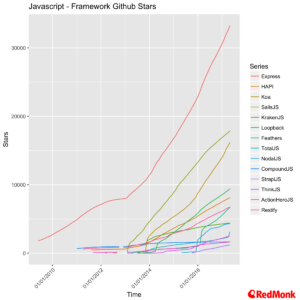
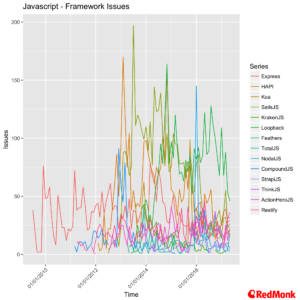
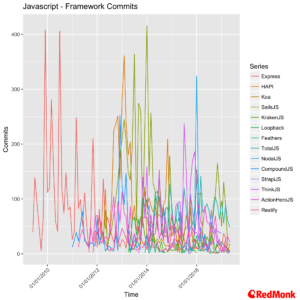
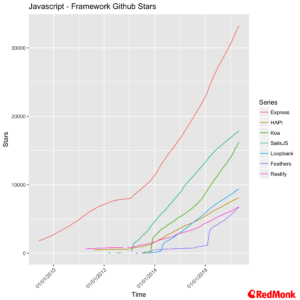
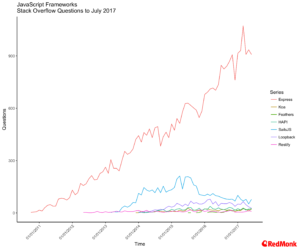
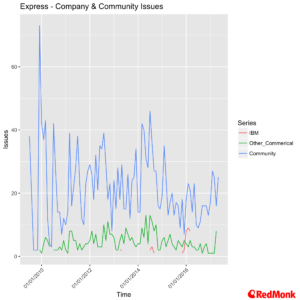
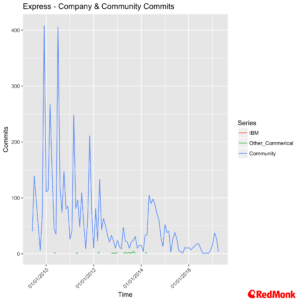
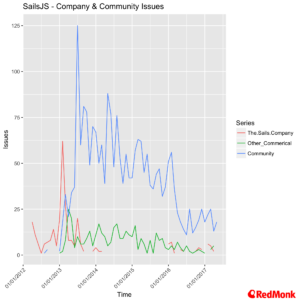
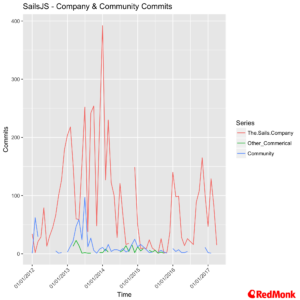
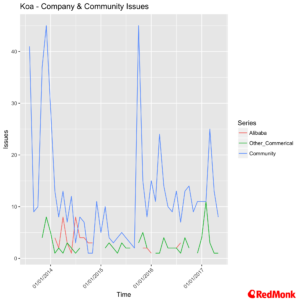
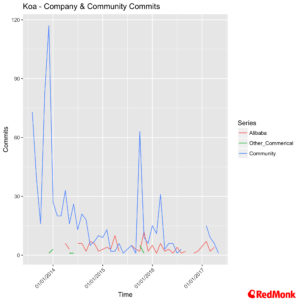
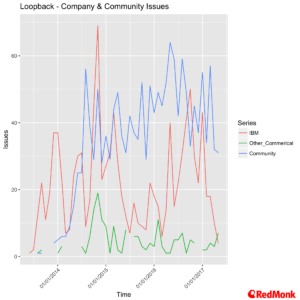
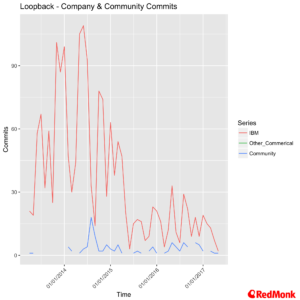
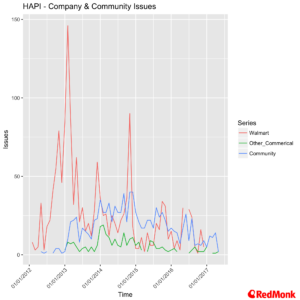
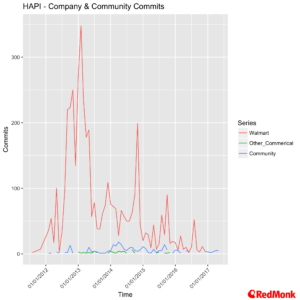
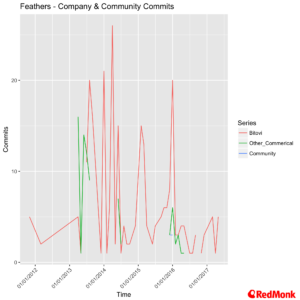
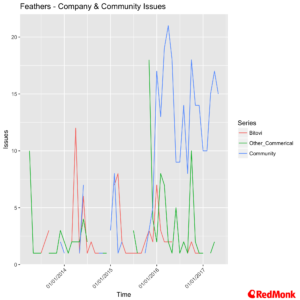
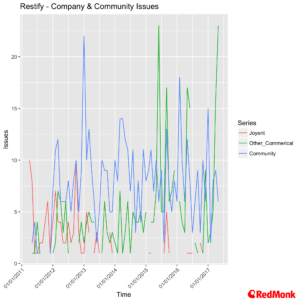
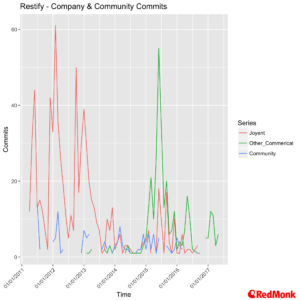
No Comments